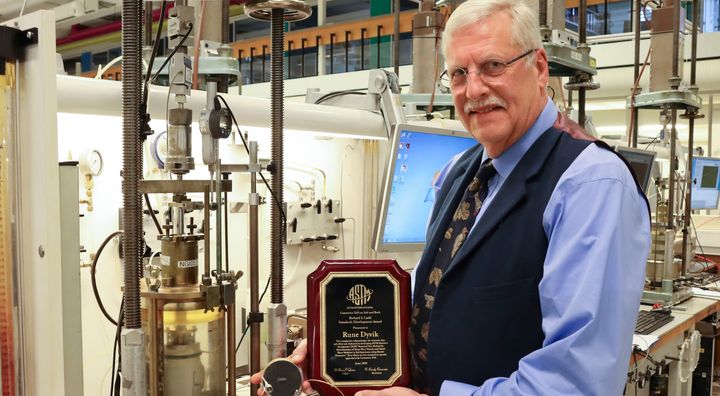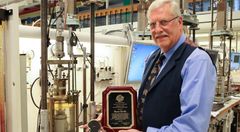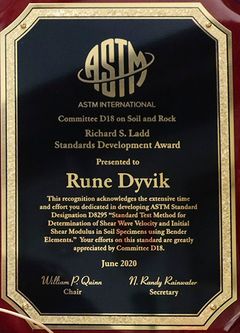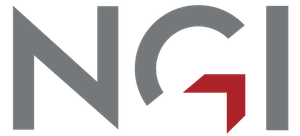ASTM Development Award to Rune Dyvik

This recognition acknowledges the extensive time and effort Rune Dyvik has dedicated in developing ASTM Standard Designation D8295 “Standard Test Method for Determination of Shear Wave Velocity and Initial Shear Modulus in Soil Specimens using Bender Elements.” These efforts on this standard are greatly appreciated by Committee D18.
The award was originally to be presented on June 29, 2020 at the Main Committee Meeting of D18 in Boston, MA, but due to the Covid 19 pandemic and associated restrictions the presentation ceremony has been postponed several times. The ASTM award was therefore shipped to Rune at this time.
Determination of initial shear modulus
The initial shear modulus, Gmax, of a soil is an important parameter for a variety of geotechnical design applications. For example, Gmax is needed to analyse and study the effect of soil-structure interaction in cyclic or dynamic loading situations, such as for earthquakes, wave loading and various sources of vibrations. The initial shear modulus is normally associated with soil shear strain levels of about 0.001% and below, for which Gmax is relatively constant and a maximum shear modulus value for a soil.
The piezoceramic bender element is an electro-mechanical transducer which is capable of converting mechanical energy (movement) either to or from electrical energy. The bender elements are installed in a variety of standard laboratory equipment types, for example triaxial, direct simple shear and oedometer devices. The transmitter element is mounted in the top cap and the receiver element in the pedestal.
During a test, the shear wave travel time from top to bottom of the specimen is measured by a digital oscilloscope or on a computer, resulting in a shear wave velocity for the soil specimen. Gmax is calculated from shear wave velocity and soil density. Bender element determinations of shear wave velocity are non-destructive. These measurements can therefore be taken at any stage of a triaxial, direct simple shear or oedometer test without interfering with the particular test itself.
The test method has been in use at NGI since 1985, but there has not been an established standard for how to conduct such tests, until now. See also link to PDF on the Bender element test.
Keywords
Contacts
Rune DyvikExpert Adviser, Laboratory and Model TestingNGI
Tel:+47 928 19 586rune.dyvik@ngi.noImages
Links
About NGI
På sikker grunn
NGI – Norges Geotekniske Institutt – er et uavhengig, internasjonalt senter for forskning og rådgivning innen ingeniørrelaterte geofag, der vi integrerer kunnskap mellom geoteknikk, geologi og geofysikk. Vår forskning gir kunnskap som styrker norsk næringsliv til å løse noen av de viktigste utfordringene vi står overfor innenfor klima, miljø, energi og naturfarer.
Gjennom årene har vi tiltrukket oss dedikerte fagfolk og internasjonale eksperter på bruk av geomaterialer som byggegrunn og byggemateriale, skredproblematikk og forurensning av grunnen. Utvikling og anvendelse av ny teknologi står helt sentralt i vår virksomhet for å finne bærekraftige løsninger og sikre at vi bygger et samfunn på sikker grunn. Vår ekspertise og løsninger er kjent og etterspurt i store deler av verden.
NGI har hovedkontor og laboratorier i Oslo, avdelingskontor i Trondheim, forskningsstasjon for snøskred på Strynefjellet, og utenlandskontorer med geoteknisk laboratorium i Houston, Texas, USA, og i Perth, Western Australia, i tillegg til samarbeidsavtaler med veletablerte selskap og institusjoner i store deler av verden.
NGI ble formelt opprettet 1. januar 1953, underlagt Norges Teknisk-Naturvitenskapelige Forskningsråd (NTNF). I 1985 ble NGI omgjort til en selvstendig stiftelse. Driftsvirksomheten (forskning og rådgivning) ble 1. januar 2024 overført til Norges Geotekniske Institutt AS, et aksjeselskap som eies 100 % av stiftelsen NGI.
Som en av hovedpartnerne støtter NGI Ingeniører Uten Grenser (IUG) økonomisk og gjennom å bidra med ingeniørkompetanse til IUGs oppdrag for norske bistandsorganisasjoner.
Subscribe to releases from NGI
Subscribe to all the latest releases from NGI by registering your e-mail address below. You can unsubscribe at any time.
Latest releases from NGI
Global modell skal gjøre verden bedre rustet mot tsunamier17.11.2025 11:46:45 CET | Pressemelding
Da en enorm flodbølge traff kystene rundt Indiahavet andre juledag i 2004, mistet mer enn 220 000 mennesker livet. Det var en katastrofe som rystet verden og som avslørte hvor lite vi egentlig forsto om tsunamier.
NGI-forsker valgt inn i styret til European Chemicals Agency (ECHA)24.10.2025 12:15:11 CEST | Pressemelding
Forsker ved NGI - Norges Geotekniske Institutt, Hans Peter Arp, er én av verdens fremste eksperter på kjemisk forurensning. Nå skal miljøkjemikeren påvirke kjemikaliepolitikken i Europa.
NGI lanserer unikt traineeprogram innen geoteknikk30.9.2025 09:11:00 CEST | Pressemelding
Fire nyutdannede ingeniører får nå muligheten til å prøve seg på tvers av NGIs kjerneområder. Gjennom et nytt traineeprogram skal de utforske alt fra fundamentering på land til havvind og klimatilpasning.
Flere velger geoteknikk og kvinneandelen skyter i været11.9.2025 08:55:38 CEST | Pressemelding
Masterstudiet i geoteknikk ved OsloMet vokser raskt. Da studiet startet i 2022, var det fem studenter og bare menn. Denne høsten har 21 nye studenter startet, av dem åtte kvinner.
Vi kan bygge tryggere tunneler med kunstig intelligens15.8.2025 14:51:34 CEST | Pressemelding
Kunstig intelligens endrer hvordan vi bygger tunneler. Vi kan forutsi farlige forhold i berget før vi treffer dem. Det gir tryggere tunneler, lavere kostnader, mindre naturinngrep og bedre beslutninger under bakken.
In our pressroom you can read all our latest releases, find our press contacts, images, documents and other relevant information about us.
Visit our pressroom


